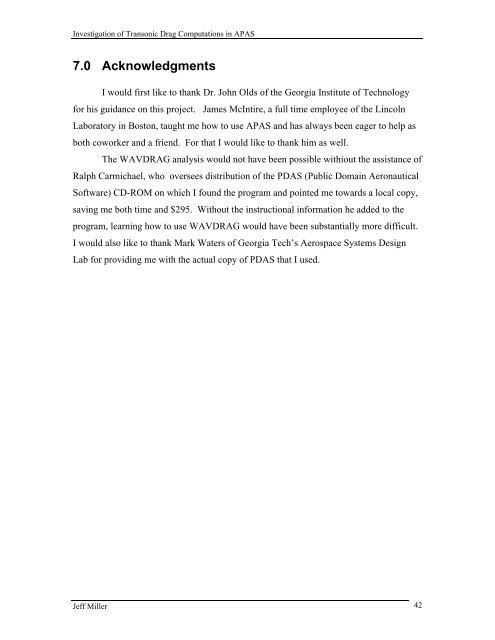Investigation of Transonic Drag Computations in Aerodynamic ...
Investigation of Transonic Drag Computations in Aerodynamic ...
Investigation of Transonic Drag Computations in Aerodynamic ...
Create successful ePaper yourself
Turn your PDF publications into a flip-book with our unique Google optimized e-Paper software.
<strong>Investigation</strong> <strong>of</strong> <strong>Transonic</strong> <strong>Drag</strong> <strong>Computations</strong> <strong>in</strong> APAS<br />
7.0 Acknowledgments<br />
I would first like to thank Dr. John Olds <strong>of</strong> the Georgia Institute <strong>of</strong> Technology<br />
for his guidance on this project. James McIntire, a full time employee <strong>of</strong> the L<strong>in</strong>coln<br />
Laboratory <strong>in</strong> Boston, taught me how to use APAS and has always been eager to help as<br />
both coworker and a friend. For that I would like to thank him as well.<br />
The WAVDRAG analysis would not have been possible withiout the assistance <strong>of</strong><br />
Ralph Carmichael, who oversees distribution <strong>of</strong> the PDAS (Public Doma<strong>in</strong> Aeronautical<br />
S<strong>of</strong>tware) CD-ROM on which I found the program and po<strong>in</strong>ted me towards a local copy,<br />
sav<strong>in</strong>g me both time and $295. Without the <strong>in</strong>structional <strong>in</strong>formation he added to the<br />
program, learn<strong>in</strong>g how to use WAVDRAG would have been substantially more difficult.<br />
I would also like to thank Mark Waters <strong>of</strong> Georgia Tech’s Aerospace Systems Design<br />
Lab for provid<strong>in</strong>g me with the actual copy <strong>of</strong> PDAS that I used.<br />
Jeff Miller 42
















